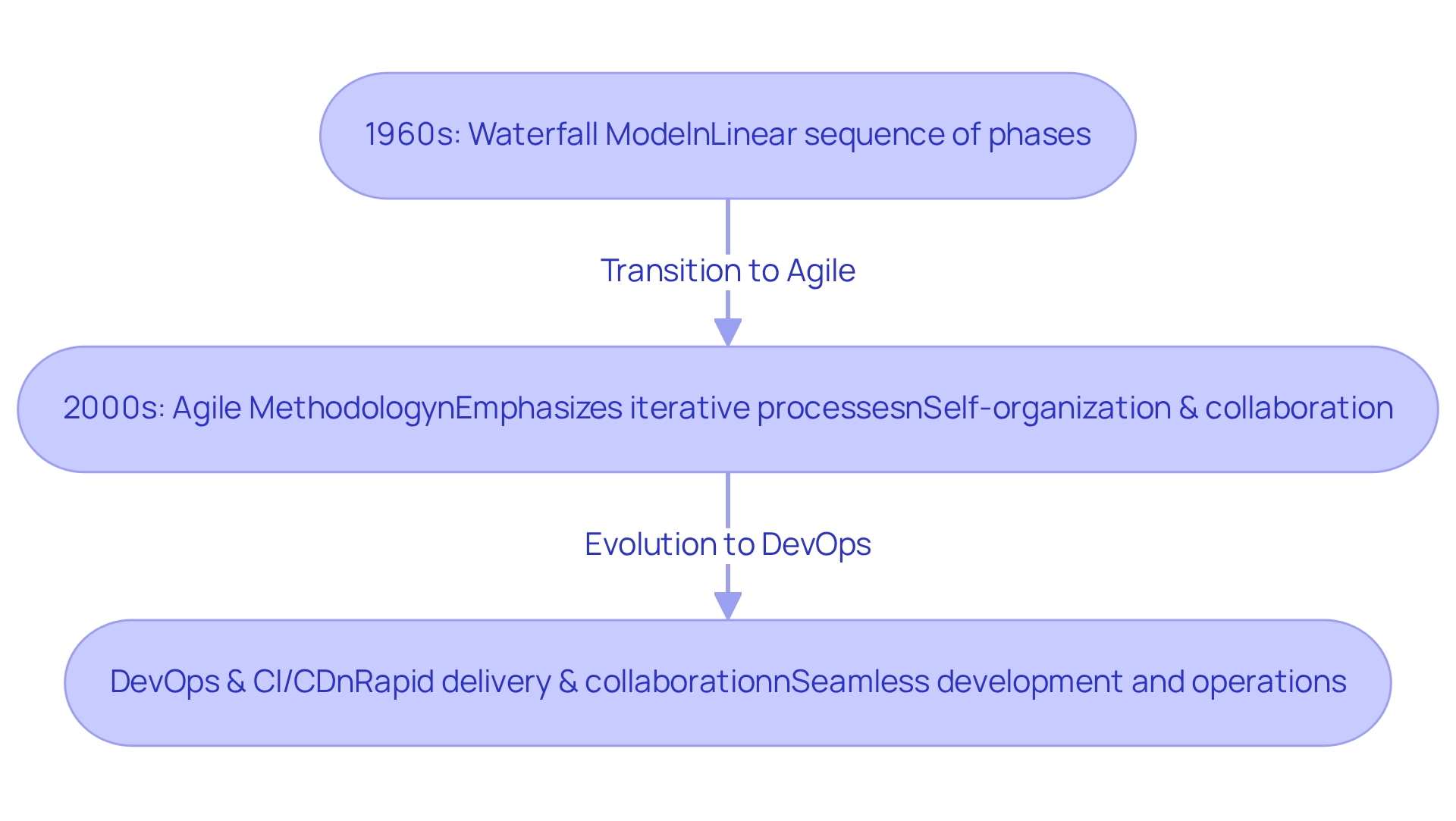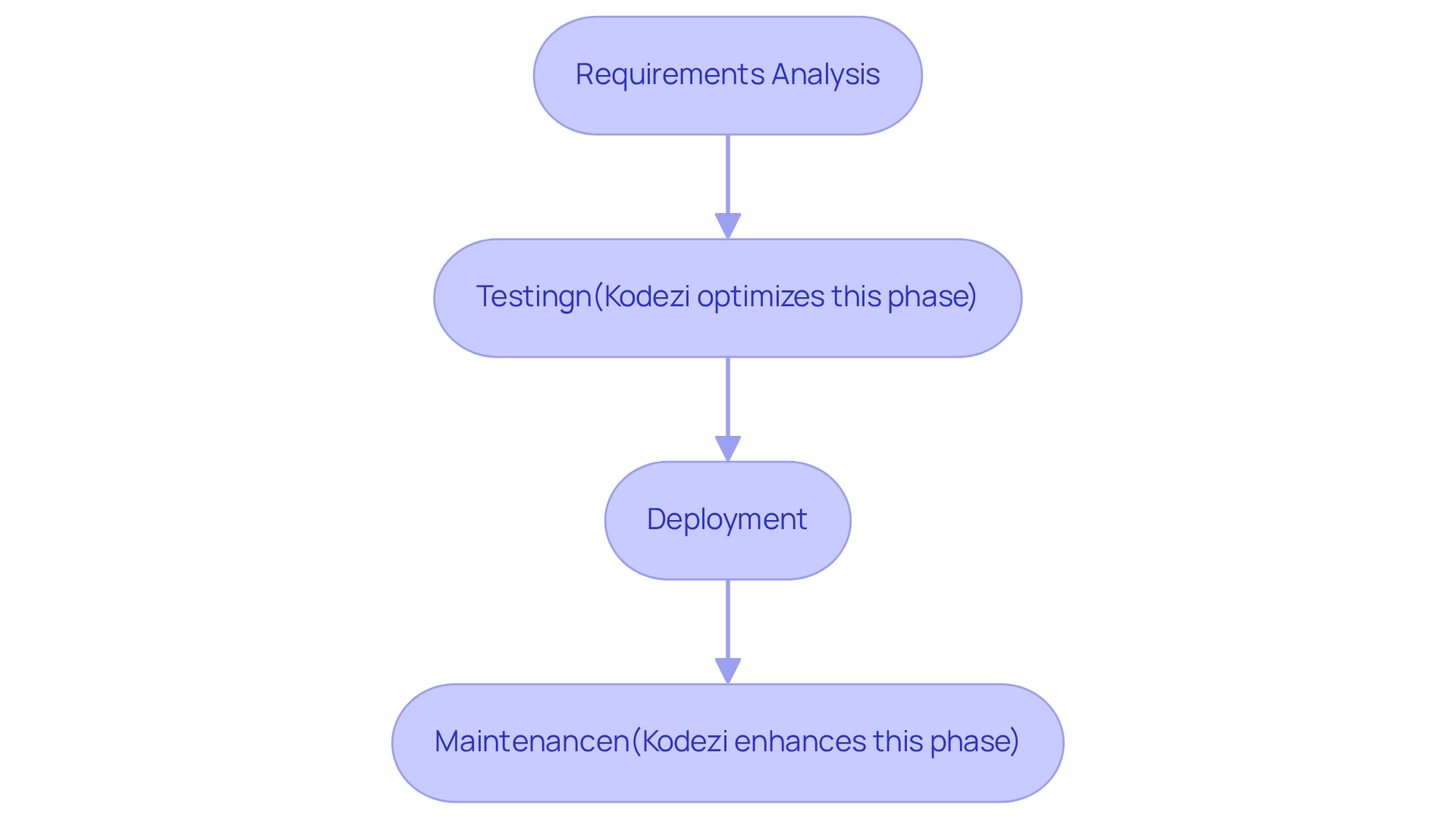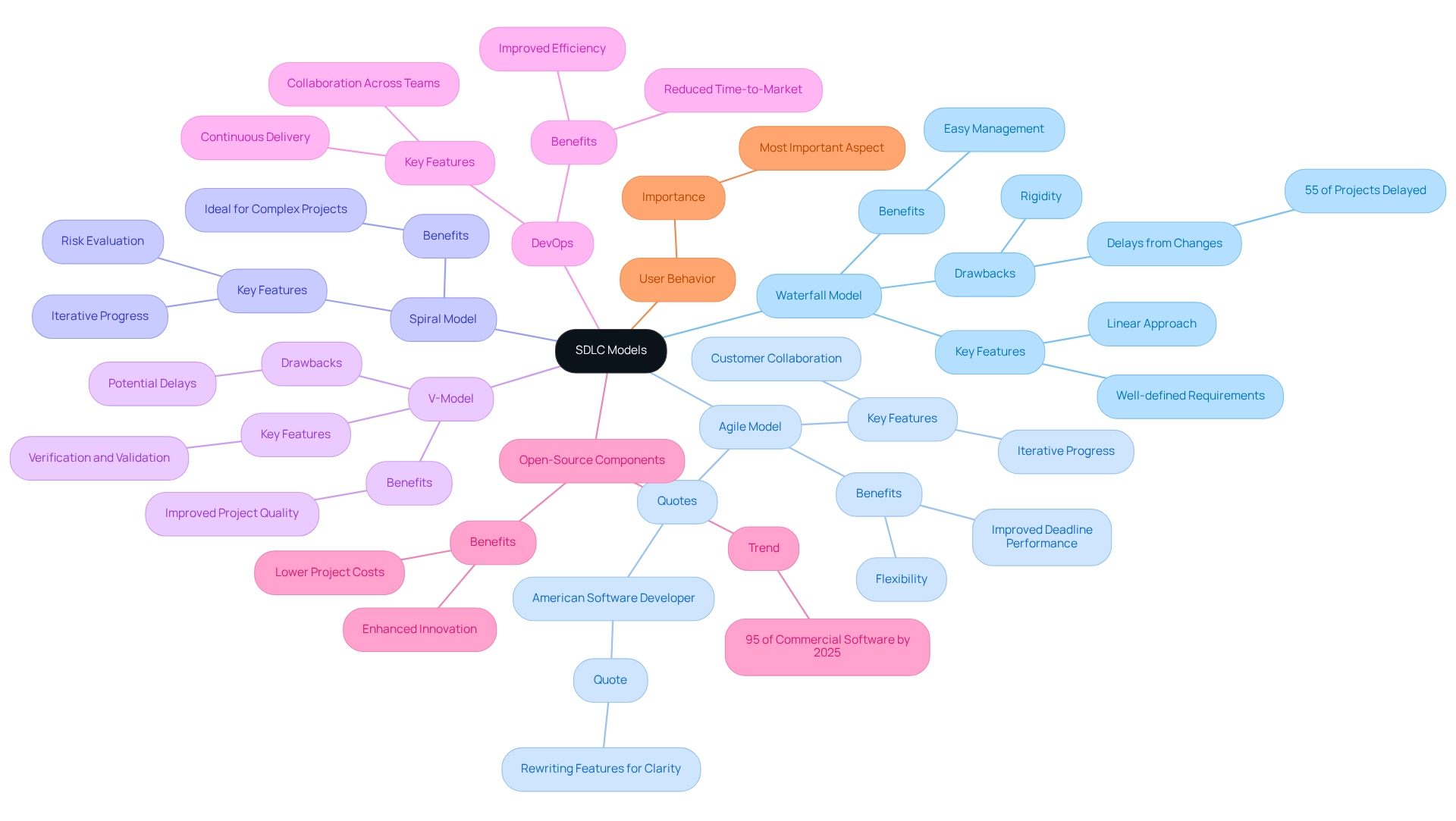Overview
The article "SDLC Explained: Key Phases and Evolution in Software Development" delves into the structured framework of the Software Development Life Cycle (SDLC) and its evolution over time. Have you ever faced challenges in managing software development projects? This article outlines the key phases of SDLC—planning, design, implementation, testing, deployment, and maintenance—while illustrating the shift from traditional models like Waterfall to more adaptable methodologies such as Agile. These methodologies enhance project adaptability and efficiency through iterative processes and collaboration.
Furthermore, understanding the SDLC can significantly improve your development practices. By adopting these frameworks, developers can better navigate the complexities of software projects, leading to improved productivity and code quality. In addition, the evolution of SDLC reflects the industry's need for flexibility and responsiveness to changing requirements.
Are you ready to transform your approach to software development? Explore the insights provided in this article to enhance your understanding of SDLC and its benefits in today's fast-paced development environment.
Introduction
In the ever-evolving landscape of software development, developers face numerous coding challenges that can impede progress. The Software Development Life Cycle (SDLC) serves as a critical framework that guides teams through the intricate process of creating high-quality software. From the initial planning stages to deployment and maintenance, each phase of the SDLC is designed to ensure that projects not only meet but often exceed user expectations.
As methodologies shift towards Agile practices, developers are discovering innovative ways to enhance efficiency and responsiveness, leading to faster project completion and improved collaboration.
This article delves into the various aspects of SDLC, tracing its evolution, outlining key phases, and comparing different models. Ultimately, it highlights the importance of a structured approach in navigating the complexities of modern software development.
Define Software Development Life Cycle (SDLC)
The Software Creation Life Cycle, also known as SDLC explained, is a structured framework that outlines the phases involved in the creation of applications. This organized procedure encompasses stages like:
- Planning
- Design
- Implementation
- Testing
- Deployment
- Maintenance
This framework directs teams toward the successful delivery of products. The primary aim of the SDLC explained is to create high-quality applications that not only meet but often surpass customer expectations, all while adhering to timelines and budget constraints. By employing a defined methodology, teams can ensure that critical steps are not overlooked, thereby enhancing the likelihood of project success.
Current trends show that Agile methodologies have gained traction, with adoption rates among programming teams reaching an all-time high. As Viraj Mahajan observes, "Today, Agile adoption among teams in the software industries is at an all-time high." Projects using Agile methods tend to be completed faster than those following traditional waterfall approaches, reflecting the efficiency that structured development processes can provide.
A vital element of contemporary software development life cycle practices is the incorporation of automated testing and debugging tools, such as Kodezi's automated code debugging feature. This tool allows teams to quickly identify and resolve codebase issues, providing detailed explanations and insights into what went wrong and how it was fixed. Kodezi addresses performance bottlenecks, identifies security vulnerabilities, and enhances code formatting, ensuring that codebases adhere to the latest security best practices and coding standards. This swift problem resolution not only improves performance but also greatly enhances the overall quality of the application being developed.
Real-world instances demonstrate the effectiveness of the SDLC explained in various sectors. For example, a case study on application creation trends across sectors shows that grasping industry-specific lifecycle practices can greatly improve business operations. Moreover, statistics indicate that 59% of remote programmers report heightened productivity compared to other work settings, emphasizing the beneficial effect of organized coding procedures on efficiency. Ultimately, the aim of the lifecycle in application creation is to offer a clear roadmap that aids in the production of strong, dependable, and user-focused solutions.
Trace the Evolution of SDLC
The evolution of the Software Development Life Cycle (SDLC) explained has significantly addressed the increasing complexity of programming projects since its inception in the 1960s. Initially, the Waterfall model dominated, following a linear sequence of phases that suited the predictable nature of early software creation. However, as the industry transformed, so did the methodologies. The early 2000s saw the emergence of Agile, a paradigm shift that emphasized iterative processes, collaboration, and flexibility, allowing teams to swiftly adapt to changing requirements. As Mike Cohn noted, self-organization within a team fosters ownership of the work, a fundamental aspect of Agile methodologies. This shift marked a departure from the rigid structures of Waterfall, cultivating a culture of continuous improvement and adaptability.
The SDLC explained today includes a variety of models, such as DevOps and Continuous Integration/Continuous Deployment (CI/CD), reflecting the industry's demand for rapid delivery and responsiveness. These methodologies facilitate seamless collaboration between development and operations, ensuring applications can be launched quickly and effectively. Kathryn Barrett aptly stated, "Falling in love with code means falling in love with problem solving and being a part of a forever ongoing conversation," highlighting the collaborative essence of modern programming practices.
The evolution of lifecycle practices, as SDLC explained, illustrates a broader trend towards agility and innovation in application development, empowering teams to navigate contemporary project complexities with greater ease. For instance, Kodezi's code translation capabilities exemplify how Agile and DevOps methodologies boost productivity by enabling developers to switch effortlessly between different frameworks and programming languages. User testimonials underscore Kodezi's transformative impact on debugging and programming efficiency, with one user sharing, "Kodezi has helped me find and fix bugs faster and easier than trying to manually. It is a lifesaver when it comes to correcting issues and bugs." Furthermore, Wietse Venema emphasizes that software can fail due to errors or unforeseen factors, underscoring the importance of flexibility in the software development lifecycle, particularly within Agile methodologies that allow for iterative enhancements. As another user remarked, "It has drastically improved our engineering team’s productivity and allowed us to focus on higher-level tasks," showcasing Kodezi's role in enhancing overall efficiency.

Outline the Key Phases of SDLC
The stages of the Software Development Life Cycle (SDLC) explained are critical in guiding the process of software creation. Developers often face significant coding challenges, such as managing complex requirements and ensuring code quality. How can these challenges be effectively addressed?
Enter Kodezi, a tool designed to tackle these issues head-on. Its automatic code correction and debugging capabilities allow developers to focus on creating efficient code while minimizing errors. Furthermore, Kodezi prioritizes user privacy, ensuring that code and data remain secure, which distinguishes it from competitors like Copilot. The process of the SDLC explained is crucial for delivering a high-quality product that meets user needs and industry standards. For example, during the Requirements Analysis phase, developers gather and analyze user needs to create a Software Requirement Specification (SRS) document. This document is vital for capturing intentions, requirements, and potential risks, ensuring all stakeholder needs are addressed.
Similarly, in the Testing stage, various tests are conducted to identify and fix defects before deployment. Kodezi's capabilities in bug analysis and optimization streamline this process, enabling developers to resolve issues quickly and enhance code quality. This leads to a smoother Deployment phase, where the application is released to users and must operate effectively in a live environment.
Finally, the Maintenance stage is essential for ongoing support and updates to address any post-deployment issues. As noted by Siddhant Khisty, Product Executive at Devtron, this phase is crucial for resolving issues, enhancing performance, and adding new features to keep the software operational and secure, as the SDLC explained shows; by incorporating Kodezi into your workflow, you can significantly enhance productivity and code quality throughout the process. Why not explore the tools available on the platform? With Kodezi, you can experience the benefits of automated debugging and advanced code optimization, ensuring that your software development process is both efficient and effective.

Compare Different SDLC Models
Developers often face significant coding challenges when navigating the complexities of software development. The concept of various Software Development Life Cycle (SDLC) models is sdlc explained, showcasing unique approaches for creating applications, each with its own set of benefits and drawbacks.
Waterfall Model: This linear approach is straightforward to manage, making it suitable for projects with well-defined requirements. However, its rigidity can lead to challenges when changes are necessary, often resulting in delays. In fact, 55% of projects experience delays due to last-minute changes and scope creep. This statistic underscores the limitations of this model in dynamic environments.
Agile Model: Agile emphasizes iterative progress and customer collaboration, enabling teams to adjust swiftly to changing requirements. This flexibility is particularly beneficial in fast-paced projects, where responsiveness can significantly enhance project outcomes. Studies show that Agile methodologies often outperform Waterfall in meeting deadlines. As noted by an American software developer, "The best reaction to 'this is confusing, where are the docs' is to rewrite the feature to make it less confusing, not write more docs," highlighting the importance of clarity in Agile processes.
Spiral Model: This model combines iterative progress with systematic risk evaluation, making it ideal for large and complex projects. By focusing on risk management, the Spiral Model helps teams navigate uncertainties effectively, fostering innovation while maintaining control over project scope.
V-Model: An extension of the Waterfall model, the V-Model emphasizes verification and validation at each phase of creation. This organized method guarantees that every stage is comprehensively evaluated prior to proceeding, which can improve overall project quality but may also delay the progression of the work.
DevOps: By merging programming and operations, DevOps enables continuous delivery and quicker deployment cycles. This model promotes collaboration across teams, leading to improved efficiency and reduced time-to-market.
Furthermore, the incorporation of open-source components is becoming more common, with projections indicating that by 2025, 95% of all commercial applications will include some open-source elements. This trend indicates a movement towards more cooperative and adaptable solutions, enhancing innovation and lowering project costs.
As sdlc explained, each software development lifecycle model addresses various project needs, and the selection process should take into account elements like project size, complexity, and stakeholder requirements. As the environment of application development evolves, comprehending the sdlc explained models becomes essential for attaining successful project results. Additionally, user behavior is the most important aspect of software from a user's perspective, and different SDLC models must cater to these needs to ensure satisfaction and effectiveness.

Conclusion
The Software Development Life Cycle (SDLC) is a crucial framework that supports successful software development by providing a structured approach to navigate its complexities. By outlining essential phases such as:
- Planning
- Requirements analysis
- Design
- Implementation
- Testing
- Deployment
- Maintenance
SDLC enables development teams to deliver high-quality software that meets user expectations while adhering to timelines and budgets.
Furthermore, the evolution of SDLC reflects a broader shift towards agility and responsiveness in software development. The transition from traditional methodologies, like the Waterfall model, to Agile practices has empowered teams to adapt swiftly to changing requirements, fostering collaboration and continuous improvement. As evidenced by various real-world examples and the integration of modern tools like Kodezi, adopting Agile and DevOps methodologies enhances productivity and efficiency, allowing developers to concentrate on delivering value rather than being hindered by rigid processes.
Ultimately, selecting the appropriate SDLC model is vital for project success, as each model presents unique advantages tailored to different project needs. By understanding the strengths and limitations of models such as:
- Waterfall
- Agile
- Spiral
- V-Model
- DevOps
development teams can make informed decisions that align with their goals and user needs. Embracing a structured yet flexible approach in software development is essential for navigating the evolving landscape and achieving robust, reliable, and user-centric software solutions.
Frequently Asked Questions
What is the Software Creation Life Cycle (SDLC)?
The Software Creation Life Cycle (SDLC) is a structured framework that outlines the phases involved in the creation of applications, including planning, design, implementation, testing, deployment, and maintenance.
What is the primary aim of the SDLC?
The primary aim of the SDLC is to create high-quality applications that meet or exceed customer expectations while adhering to timelines and budget constraints.
How does the SDLC enhance project success?
By employing a defined methodology, the SDLC ensures that critical steps are not overlooked, thereby enhancing the likelihood of project success.
What current trends are observed in software development methodologies?
Agile methodologies have gained significant traction, with an all-time high adoption rate among programming teams, leading to faster project completion compared to traditional waterfall approaches.
What role do automated testing and debugging tools play in the SDLC?
Automated testing and debugging tools, like Kodezi, allow teams to quickly identify and resolve codebase issues, enhancing performance, security, and overall application quality.
How does Kodezi contribute to the software development process?
Kodezi addresses performance bottlenecks, identifies security vulnerabilities, and enhances code formatting, ensuring adherence to security best practices and coding standards.
What evidence supports the effectiveness of the SDLC in different sectors?
Real-world instances and case studies show that understanding industry-specific lifecycle practices can greatly improve business operations, with statistics indicating that 59% of remote programmers report heightened productivity due to organized coding procedures.
What is the ultimate goal of the SDLC in application creation?
The ultimate goal of the SDLC is to provide a clear roadmap that aids in producing strong, dependable, and user-focused solutions.




